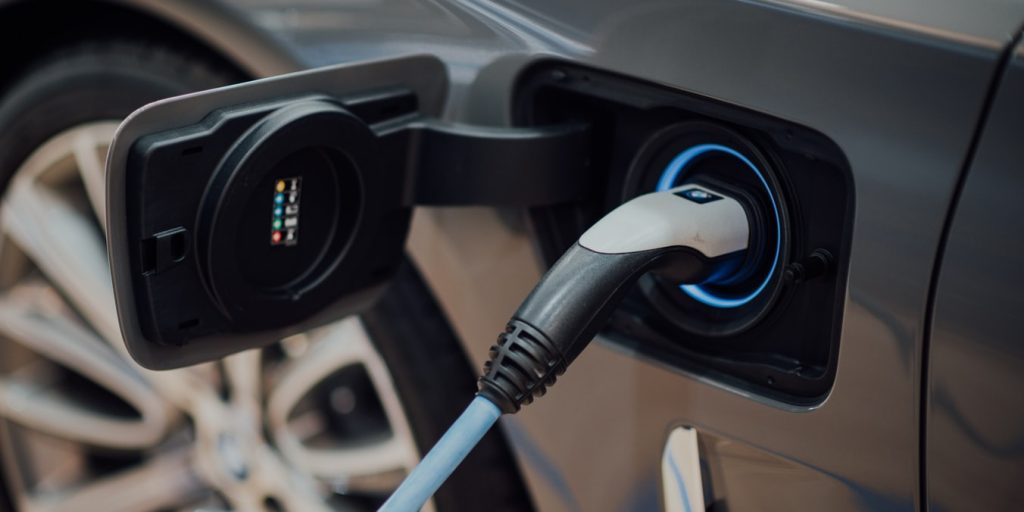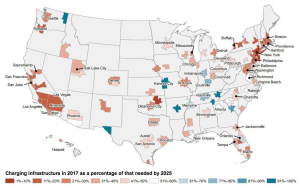Electric vehicle infrastructure in the post-COVID city: Planning for a green recovery
If there is a benefactor from the coronavirus pandemic, it’s the environment. For example, this year is set to show the largest ever annual fall in Co2 emissions. However, as cities all over the world begin to emerge from lockdown, emissions will inevitably creep back up again.
Mayors and other civic leaders don’t want this environmental change to be a false dawn. Therefore, many are looking at how to shape a green recovery. This has already seen an increase in bike lanes and pedestrianization. While this will encourage greener choices for short trips, cars are likely to remain the default choice for longer distances.
In which case, for a sustainable and long-term green recovery, cities need to begin planning and investing in electric vehicle (EV) infrastructure.
The current state of EV infrastructure in the US
There’s a growing concern that EV infrastructure is not correlating with the number of electric vehicles forecasted to be on the road in the next 5-10 years.
Right now, the number of electric vehicles in an area usually matches the amount of charging stations. The areas with the highest number of EVs at present are California, other coastal states, and metropolitan areas. However, the number of EVs on the road is set to triple from one million to three million by 2025. This prediction, made by the International Council for Clean Transportation, also attempts to map out the year-over-year percentage increase in EV infrastructure chargers each state will need to make to meet current demand:
As you can see, New York, Boston, and Oklahoma City stand out as places where increased EV infrastructure is particularly vital. However, in a post-COVID economy, will there be funds available to invest in this infrastructure?
The challenges cities face when planning and installing EV charging stations
The biggest issues that cities and states will face when investing in EV charging stations post-COVID are financial, with budgets expected to take a significant hit from the economic fallout .
This isn’t surprising when you consider the drop in consumer spending. On average, sales taxes make up almost half of a state’s tax revenue. As a result, some may determine that installing EV charging stations is not a high priority. However, if they’re in an area that is not currently on track to meet EV infrastructure requirements, it becomes a ticking bomb.
Another challenge that cities can face is the number of bottlenecks involved in the planning and installation of EV charging stations. Red tape and bureaucracy can drive the cost of EV charging stations up significantly. A study by the Rocky Mountain Institute revealed that the soft costs of installing chargers can be three to five times higher than the chargers themselves. These can include:
- Permitting delays
- Re-engineering projects that are based on incorrect information
- Difficult utility interconnection processes
One potential way of avoiding these roadblocks is by addressing the issue in advance during building construction. Installing charging capacity during construction may reduce costs by nearly 75%.
Federal grants for EV charging stations: EVs > EV infrastructure
There is funding available for cities and municipalities worrying about the cost of investing in green infrastructure. However, it’s still not quite at the level it should be.
The majority of the funding available, especially at the federal level, is directed toward EVs themselves and the people buying them. Not the public entities, businesses or citizens installing charging infrastructure. For example, there has been a large movement throughout the country for electrifying public fleets – this growth has been made all the more possible thanks to EV federal grants.
That being said, there are still funding options for electric vehicle charging stations available, especially at the state and local levels of government and by electric utilities.
When it comes to federal funding, here are some of the options available:
- Clean Cities Coalition Network – The Clean Cities Coalition contains nearly 100 volunteer coalitions nationwide who aim to develop public/private partnerships that promote alternative and renewable energy. Partnerships are a vital way in which you can make the electric vehicle infrastructure process as smooth as possible.
- Electrify America – This initiative was formed out of the EPA’s settlement with Volkswagen over its Dieselgate emissions scandal. At the moment of writing, the program is already implementing what will be a $2 billion charging network by 2027.
- The Vehicle Technologies Office (VTO) supports a variety of work to lower the cost and increase the convenience of plug-in electric vehicles. VTO is currently collaborating with national laboratories and the industry to improve batteries and electric drive systems.
As the previous map points out, there is a disparity between different states’ demands for green infrastructure. This imbalance may be why federal funding is harder to come by. The best way to check for programs in your area is by visiting your state’s or Commonwealth’s website, which should show the programs and funding options available.
Form partnerships with businesses and other stakeholders – it’s better to get some outside help
With financial funding for EV charger stations still developing at a federal level, one potential avenue available is to form partnerships with other businesses and stakeholders.
Firstly, you can network with businesses and stakeholders who may also mutually benefit from installing EV charging stations. However, that may require bringing in expertise in funding options and siting locations for EV charging stations. And during the current economic situation facing many businesses, it may prove difficult to find a partner willing to commit the resources. Moreover, with these challenges in installing EV charging stations, you could end up overpaying on soft costs that blow your budget.
You can sidestep this by becoming a member of a third-party energy buying consortium. This may require committing more resources, but it will save on bottleneck costs down the road. Research the energy buying consortiums near you and assess what they can bring to the different stages of the journey: negotiation, installation, ownership, operation, and maintenance.
Here are some questions to ask when looking for an energy buying consortium with an electric charging station program:
- What’s their level of experience? You want to find someone that has a lot of experience in multiple areas of energy. This not only shows they will last the longevity of your project but also indicates they have a lot of relationships that may be helpful (EV charger installers, software companies, contractors, fellow members who may have similar experiences, etc) Moreover, they’ll be able to guide you through the process if they’ve implemented other similar projects many times over.
- How much negotiating will you need to do? Negotiating with contractors is time-consuming and costly. Therefore, you want to partner with a consortium who has already done the negotiation process for you and can offer a discounted price on the equipment. This way you can ensure you’re getting the best deal possible and you don’t need to bring in other external resources to finalize the project.
The Bottom Line
To ensure that the environmental positives of COVID-19 aren’t just a flash in the plan, cities need to start investing in EV infrastructure. It’s an important step to getting more electric vehicles on the road, but it cannot happen without the correct infrastructure.
At this moment in time, the federal government is not prioritizing funding for EV charging stations. However, by doing research at the state level and looking into brokering deals through a third-party energy buying consortium, it’s still possible to avoid the soft costs that can plague EV infrastructure and gain the expertise required to successfully build infrastructure in the new social distancing reality.
Kristen Patneaude is director of innovation at PowerOptions, a nonprofit energy consortium operating in Massachusetts, Connecticut and Rhode Island, which supports nonprofits’ and public entities’ clean transportation efforts with discounts on electric vehicle charging stations and group purchasing of electric fleets.





















